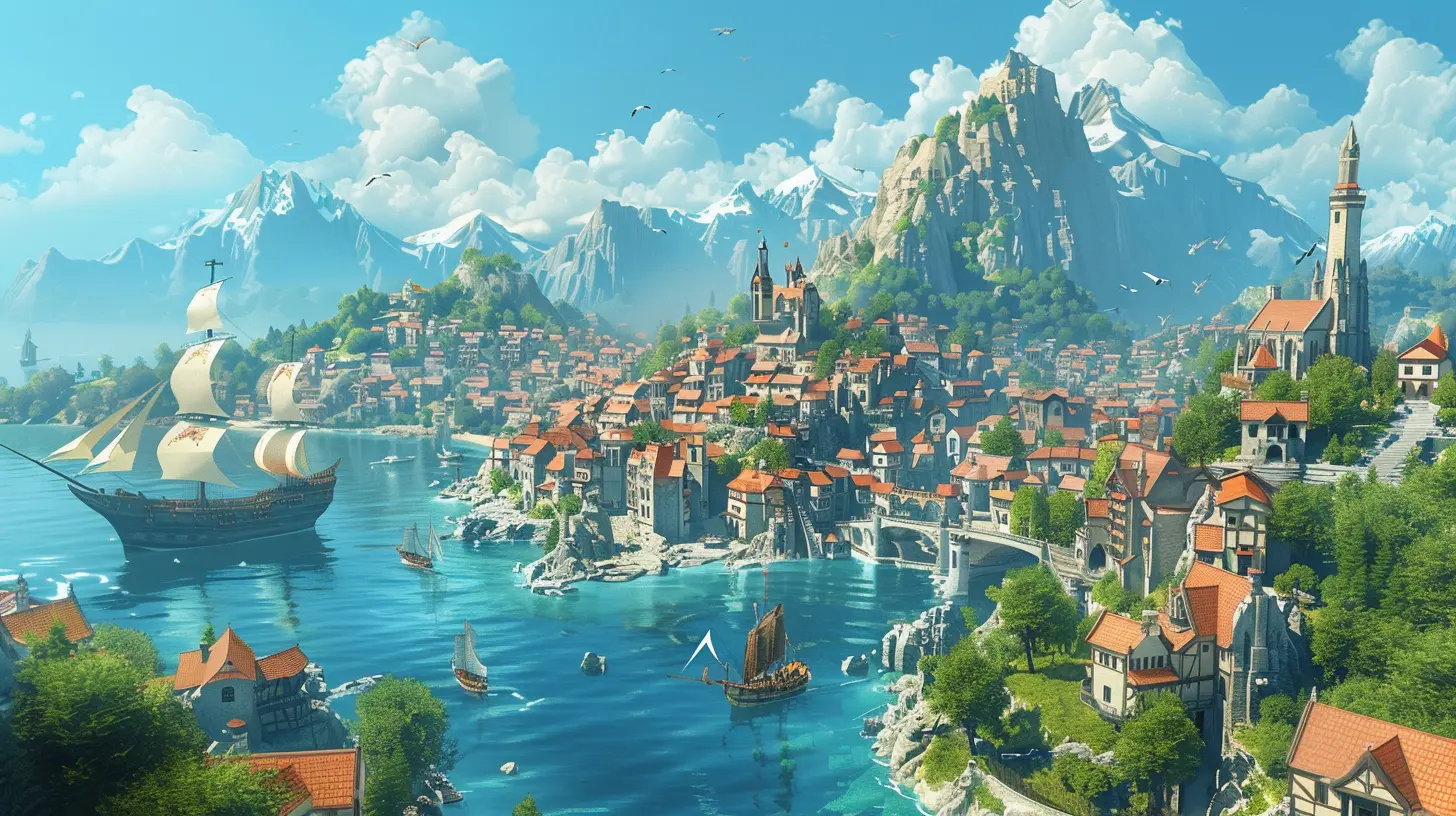Handling Large Worlds: Which Game Engine Manages Open Worlds Better?
9 November 2025
Open-world games—don’t we all love them? These immersive, sprawling digital playgrounds have become one of gaming’s most beloved genres. There’s something magical about losing yourself in a massive map, discovering hidden secrets, or just aimlessly wandering while soaking in breathtaking landscapes. But creating such colossal worlds isn’t as simple as popping a few trees on a map and calling it a day. It’s a deeply technical process that involves game engines—those unsung heroes powering our gaming adventures.
Now, you might be wondering, "What’s the big deal with game engines? Aren’t they all the same?" Not quite. Some game engines are like Ferraris—fast, sleek, and designed for specific tasks. Others are more like Swiss army knives—they can do a bit of everything, but maybe they’re not the best at all of it. So, which game engine manages open worlds better? Let’s dive in.
What Makes a Game Engine Suitable for Open Worlds?
Before spilling the beans on which game engines stand out, let’s get one thing straight—building an open world is hard. Developers have to juggle performance, visuals, physics, AI, and gameplay mechanics all at once. A game engine that handles open worlds needs to check quite a few boxes:1. Scalability – Can the engine handle massive maps without turning your gaming rig into a sputtering mess?
2. Optimization – How well does it manage memory, data streaming, and rendering large scenes filled with complex assets?
3. Ease of Use – Does it provide tools that developers can work with efficiently, or does it feel like solving a Rubik’s Cube in the dark?
4. Dynamic Systems – From weather effects to NPC AI, can the engine juggle all these moving parts seamlessly?
5. Modding Support – For players and creators alike, engines that support modding can extend the life of a game for years.
With these criteria in mind, let’s look at some of the top contenders.
Unreal Engine: The Powerhouse of Open Worlds
When it comes to open-world games, Unreal Engine, developed by Epic Games, is like the Beyoncé of game engines—it’s the first name that comes to mind, and for good reason. Unreal Engine is packed with features that make it an absolute beast for creating expansive worlds.Why Unreal Engine Shines
- Nanite and Lumen: The latest Unreal Engine 5 introduced groundbreaking tech like Nanite (virtualized micropolygon geometry) and Lumen (real-time global illumination). In simpler terms, this means gorgeous visuals without frying your GPU. Think of Unreal as that friend who can multitask flawlessly while looking fabulous.- World Partition System: Managing open worlds requires chopping maps into bite-sized pieces for better performance. Unreal does this automatically with its World Partition system, ensuring smooth gameplay even on large maps.
- Robust AI and Physics: From creating believable NPC behaviors to simulating realistic physics, Unreal handles it like a champ.
Notable Games in Unreal
Unreal Engine is behind some absolute stunners, including Fortnite, The Outer Worlds, and ARK: Survival Evolved. These games prove that Unreal isn’t just about pretty visuals—it’s about performance and versatility too.
Unity: The Jack-of-All-Trades
Unity, on the other hand, is known for its flexibility and accessibility. It’s like the Swiss army knife of game development. But when it comes to open worlds, how does it hold up?Strengths of Unity
- Lightweight and Versatile: Unity might not have the sheer power of Unreal, but it’s lightweight and customizable. This makes it a favorite for indie developers who want to experiment with open worlds without breaking the bank.- Streaming Systems: Unity’s data streaming is improving every year, allowing developers to load vast terrains without putting all the strain on hardware.
- Cross-Platform Support: If you’re aiming for multiplatform games, Unity’s compatibility is unmatched. It’s great for smaller open-world projects that span PC, consoles, and mobile devices.
Where It Falls Behind
Unity isn’t quite as plug-and-play when it comes to detailed open-world features. Developers often have to turn to third-party tools or write custom code to achieve the same level of performance and visuals as Unreal. Think of it as a DIY project—it can get the job done, but it might require some extra elbow grease.Famous Unity Titles
While Unity isn’t as synonymous with big-budget open-world games, titles like Rust and Subnautica show what it’s capable of in the hands of skilled developers.
CryEngine: The Master of Visuals
CryEngine is a lesser-known but powerful contender when it comes to open worlds. If Unreal is Beyoncé, CryEngine is more like Adele—fewer releases, but when it delivers, it delivers.CryEngine’s Superpowers
- Jaw-Dropping Graphics: CryEngine has always been synonymous with stunning visuals. It’s no surprise, considering it’s the engine behind Crysis—yes, the game that made everyone ask, "But can it run Crysis?"- Realistic Environments: From dynamic water to detailed vegetation systems, CryEngine excels in creating realistic and immersive open-world settings.
The Downsides
CryEngine’s steep learning curve and relative lack of community support compared to Unreal or Unity can make it feel a bit intimidating. Developers often describe it as having a lot of potential, but not being the easiest to work with.Games That Use CryEngine
The Far Cry series owes much of its lush environments to CryEngine (at least the earlier titles). It’s also used in Kingdom Come: Deliverance, which showcased some of the most beautiful medieval landscapes in gaming.Other Challengers: Frostbite and Snowdrop
While Unreal, Unity, and CryEngine dominate the discussion, let’s not ignore some proprietary engines built by studios for their own projects.Frostbite
- Developed by EA, Frostbite is the engine powering games like Dragon Age: Inquisition and the Battlefield series. It excels at large environments and dynamic physics but has a reputation for being difficult to work with.Snowdrop
- Ubisoft’s Snowdrop Engine is behind The Division. Its procedural generation tools and real-time lighting are perfect for urban open-world settings.So, Which Engine Manages Open Worlds Better?
If we’re playing a game of "Who Wore It Best?" in the open-world genre, the answer depends on what you’re looking for. Want AAA visuals and cutting-edge tech? Unreal Engine is your go-to. Looking for something versatile and budget-friendly? Unity’s got your back. Obsessed with photorealistic environments? CryEngine might just blow your mind.At the end of the day, it’s like comparing apples, oranges, and bananas—they’re all fruits, but your preference depends on your taste (and gaming goals).
What About the Future?
With rapid advancements in game development, engines are continuously evolving. Unreal 5’s Nanite has already set a new standard for open-world visuals, but who knows what’s on the horizon? Maybe AI-driven world generation or even fully procedurally generated maps in seconds? Whatever the future holds, one thing’s for sure—we gamers are in for a treat.Wrapping It Up
Open-world games are bigger and better than ever, thanks to game engines that push the boundaries of what’s possible. Whether you're an indie dev or a AAA studio, choosing the right engine is like choosing the right tool for the job—it can make or break your project. Unreal Engine, Unity, CryEngine, and others each bring their own flair to the table. The real winners? Us, the players, who get to roam these breathtaking worlds.all images in this post were generated using AI tools
Category:
Game EnginesAuthor:

Avril McDowney
Discussion
rate this article
1 comments
Marigold Hughes
Choosing a game engine for open worlds? It's like picking the best pizza topping!
November 10, 2025 at 4:45 AM


